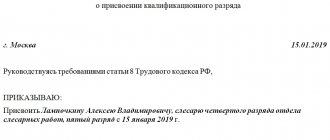In what cases does the professional standard of a car driver apply?
The professional driver standard for 2020 is under development. It is planned that it will apply to all workers engaged in transportation on vehicles weighing over 3,500 kg and carrying more than 8 people. Currently, the professional standards “Automotive Logistician”, “Off-Road Motor Vehicle Driver”, etc. are in force.
Download documents from the article
The existing draft professional standard covers categories of drivers from “B” to “D1E”. In addition, trolleybus drivers not mentioned in the project, as well as those involved in the transportation of dangerous and/or oversized cargo, will have to confirm their qualifications.
The project contains requirements:
- General character.
- Towards qualification.
- For the qualifying exam
- To the examiner.
Please note: the law does not require drivers of passenger cars to meet professional standards. The vehicle category is determined by the vehicle passport.
According to the new rules, draw up work schedules for drivers
When creating driver work schedules, take into account the latest changes from the Ministry of Transport. If you do not take the changes into account, the State Tax Inspectorate will fine you up to 50 thousand rubles for incorrect schedules for drivers and other violations. Read more in the new issue of the magazine “Human Resources Directory”
Loader
Requirements for forklift drivers are established in the professional standard “Automotive Logistician”, approved by Order of the Ministry of Labor dated October 14, 2014 No. 721n. We list the main functions of this specialty:
- Transportation of inventory items (material assets) along the specified route.
- Cargo safety control.
- Preparation of route reports.
- Route planning and monitoring its implementation.
- Active participation in optimizing your work (deliveries, work processes).
Trucks and cars
A truck driver, according to the draft professional standard, must be competent in the rules for using a vehicle and transporting cargo. This means that he:
- Must understand the principles of the machine and trailer and have a license in the appropriate category.
- Regular inspections are carried out correctly.
- Monitors compliance with safety regulations during loading and unloading.
- Maintains his level of qualifications, including work-rest schedule, correct driving behavior, etc.
The driver of a passenger car must know:
- Traffic rules and car insurance rules.
- Warned of liability for violations
- Able to identify breakdowns and make minor repairs, etc.
Bus
Requirements for bus drivers are given in the draft professional standard “Car Driver”. There have been proposals to develop a separate “bus” standard, but so far all the requirements have been combined into one document. Perhaps this will be implemented in the future.
The specific requirements for bus drivers are related to their activities. They transport a large number of people, that is, they are responsible for the life and health of passengers.
- Knows the technical characteristics of his vehicle.
- Knows how to operate it and eliminate minor breakdowns.
- Knows how to refuel and maintain a bus.
- Competent in the rules of transporting passengers, boarding and disembarking.
- Complies with all necessary safety measures.
- Follows strictly along the planned route.
- Draws up a report on the route, hands over the bus to the ATS.
Bus driver professional standard of the Ministry of Labor
The procedure for technical inspection of vehicles registered by state authorities supervising the technical condition of self-propelled vehicles and other types of equipment in the Russian Federation
Purpose and principle of operation of the main mechanisms and devices of an off-road vehicle
Techniques for driving an off-road vehicle (driving, stopping and parking) with towed and attached equipment
Features of driving in various weather conditions and on dangerous sections of roads
Rules for towing an off-road vehicle
Rules for driving using a map, compass and satellite navigation system instruments in conditions of limited visibility and sparsely populated areas
Safety rules when working with winch cable
Other characteristics
—
3.3.2.
Professional standard for a car driver: general information
Professional standards appeared back in 2013, but at that time they were not mandatory. Since 2020, they have been applied in cases where this is provided for by the Labor Code of the Russian Federation, federal laws, and other by-laws. For example, if the job:
Download documents on the topic:
Don't miss: the main article of the month from a practical expert
5 main misconceptions about professional standards.
The professional standard for a car driver has not yet been developed, but for now the company can prepare for its implementation. By July 2016, more than 800 standards targeting 30 industries had been developed and approved. If a company plans to implement professional standards, organizations should create groups for the implementation of professional standards.
The draft professional standard establishes requirements for the knowledge, skills and abilities of vehicle drivers of the following categories and subcategories: “B”, “C”, “C1”, “D”, “D1”, “BE”, “CE”, “C1E”, "DE", "D1E". But trolleybus drivers and carriers of dangerous or oversized cargo will also have to take the exam, regardless of the open category of license. For the driver of a passenger car, professional standards are not yet provided for by law.
The draft professional standard reflects:
- Requirements for vehicles of categories and subcategories, upon successful completion of which the candidate may be allowed to drive.
- Requirements for the level of skill on the basis of which the system of advanced training is based.
- Requirements for the content of the qualifying exam, the travel route and the minimum time required to conduct it.
- Requirements for the examiner.
If the vehicle has less than 8 seats and its weight does not exceed 3.5 tons, it is planned that drivers will not be required to undergo testing. You can determine what type a car is using a technical passport. In all other cases, the car driver will be required to pass a professional standard exam.
What should an employer do after accepting a driver’s professional standard?
After the adoption of the professional standard, employers who employ drivers will need to take a number of measures. Otherwise, during inspections, the labor inspectorate may impose fines.
In particular, the organization will have to:
- Check job descriptions
for drivers, adjust the staffing table, and make adjustments to other internal documents. If necessary, changes are made to local regulations, employment contracts, as well as personal cards and other personnel documents; - Assess the level of driver qualifications and determine compliance with the requirements reflected in the professional standard. If there is a discrepancy with formal requirements, while the driver copes with job duties, carry out certification in a specialized center or certification of the employee.
What are the professional standards for car drivers?
The professional standard of a car driver is a new concept used in regulating labor relations. After the introduction of this professional standard, in a number of cases it will become mandatory for use.
Let's figure out what this professional standard is, how it should be introduced and what the consequences of non-compliance are.
Professional driver standard - what is it?
Since 2013, a new concept has appeared in Russia - a professional standard. This term means a set of qualification requirements (mainly education and work experience) applied to a particular profession and established at the federal level.
The adoption of professional standards is due to the fact that previous standards concerning the requirements for the level of qualifications of workers do not always reflect the real situation and need to be adjusted.
The same fact that professional standards are adopted at the level of the Ministry of Labor of the Russian Federation and are binding is associated with the need to protect a number of certain areas of professional activity from unskilled workers.
Initially, professional standards were indicative, but from July 1, 2020, their application became mandatory. They will be applied in cases where the Labor Code of the Russian Federation, other federal laws and regulations directly require this. Typically, this requirement is due to the fact that:
- work is carried out in government organizations;
- work is associated with the provision of certain benefits from the state or, on the contrary, the imposition of appropriate restrictions (in this case, professional standards may be mandatory even for commercial organizations).
As of June 2020, more than 800 professional standards have been adopted and approved for more than 30 different industries. Transport is one of these industries.
And one of the professions for which we should expect the introduction of mandatory professional standards in this area in the near future is the profession of a passenger vehicle driver.
Where is the professional standard for a passenger car driver applied?
According to current Russian regulations, a passenger car is a vehicle that meets the following requirements:
- its weight does not exceed 3500 kg;
- the number of passengers does not exceed 8 people.
You can more accurately determine what type a specific vehicle belongs to using the PTS. For domestic cars, digital model coding is used: if the second digit in the model number is 1, this means that this is a passenger car.
This rule applies to both Soviet-era cars (like the VAZ-2106) and modern models (UAZ-315195 Hunter). There is no such coding for foreign cars, but if necessary, an examination can be carried out and the exact type of car can be determined.
The professional standard for drivers of passenger cars should be applied in those areas of economic activity where such vehicles are used.
However, as of June 2020, no professional standard has yet been adopted specifically for drivers of passenger cars.
However, this phenomenon is temporary: the Ministry of Labor of the Russian Federation plans to increase the number of professional standards to more than 2000 by the end of 2017, and a draft document for drivers of passenger vehicles already exists, although it has not yet been approved.
At the same time, there is already a standard in force for drivers of off-road vehicles, and among SUVs there are also many cars that fall under the definition of cars.
What does the professional driver standard include?
Any professional standard adopted in Russia must correspond to the layout of the professional standard approved by the Ministry of Labor of the Russian Federation in 2013. This layout provides that each standard established for a specific profession includes several required structural parts.
Let's look at them.
General information
This part includes the official name and a brief description of the type of activity for which the professional standard was developed. The coding of the profession according to OKVED and OKZ is also indicated here.
Functional map
This term refers to a description of the functions that an employee must perform in the course of his professional activities. In relation to the driver of passenger cars, the functional map will primarily include the following:
- driving;
- its maintenance;
- transportation of passengers and cargo within the limits established for passenger vehicles.
This section also includes an indication of the level of qualification required to perform the job function and its coding.
Characteristics of generalized functions
Individual professional functions are grouped together in accordance with exactly how the division of labor occurs in the course of economic activity. The third section of the professional standard contains a description of each of these groups along with an indication of what the corresponding position should be called and what the employee occupying it should know and be able to do.
Individual actions can be coded here - from inspecting the car and checking the fluid level in the washer reservoir to driving in difficult road conditions. The specific content of the professional standard should provide for different levels of qualifications.
Information about the organizations that developed the professional standard
This section lists the developers who participated in the preparation of the professional standard. Although the standard is approved by order of the Ministry of Labor of the Russian Federation, its development can be carried out by various state and non-state organizations specializing in this area.
Moreover, the developer can be either an organization at the Gostekhnadzor level or any commercial company, if the level of qualifications of its specialists allows them to take part in the development of regulatory documentation.
How is the professional standard applied?
If an organization discovers that the accepted professional standard for drivers applies to it, it must take a number of actions. Such events include:
- Checking job descriptions for drivers, staffing schedules and other internal documents to ensure they comply with the standard. If necessary, changes are made both to local regulations and to employment contracts, personal cards and other personnel documents.
- Checking the qualification level of drivers in accordance with the requirements specified in the professional standard.
- In the event that there is no compliance with formal requirements (level of education, work experience), but the driver copes with his job duties, the organization can carry out both certification (in a specialized certification center) and certification of the employee. If, as a result of certification, a lack of qualifications at the level of its practical implementation is confirmed, this may serve as one of the grounds for dismissal.
However, instead of dismissal, the organization can enter into an agreement with the employee and send him for training, upon completion of which his qualifications will meet the requirements of the professional standard.
Responsibility for non-compliance with professional standards
It must be remembered: since July 2020, professional standards are no longer recommendations, but regulatory documents, and if they are not observed in a particular organization, it may be held accountable. The sanctions in this case include an administrative fine of up to 50 thousand rubles.
Source: https://neplatno.com/nazvanie-kategorii/kakovy-profstandarty-u-voditelej-legkovyx-avtomobilej
General requirements for vehicle drivers
The driver’s responsibilities include driving a vehicle of the appropriate category or subcategory with a given quality in various road conditions. Full compliance with work and rest schedules is also important.
According to the draft professional standard, high demands are placed on the professionalism of car drivers. That is why not everyone can pass the standards, since the slightest violations do not allow confirming the level of qualifications.
According to the professional standard project, a car driver must be able to:
The level of knowledge is also controlled. The driver must not only be able to drive a vehicle, but also understand some of the nuances in order to optimize the work and make it safer.
According to the professional standard project, a car driver must know:
It is possible to identify the main qualities of a driver that affect his compliance with professional standards. These include personal qualities, qualifications, health status, taking medications, alcohol, and drugs. Work schedule also has an impact. If an employee is given a lot of workload and responsibility, over time he gets tired and, accordingly, copes with his responsibilities worse.
A professional driver who knows the basics of effective, environmentally friendly and safe driving can:
The draft professional standard for a car driver stipulates that an employee must be able to drive a vehicle in any weather conditions, including rain, snow, and ice. At the same time, a professional driver assesses possible risks and takes precautions. In the event of a traffic accident, it is required to maintain stable behavior and quickly provide first aid if necessary.
The employee is responsible for carrying out maintenance and troubleshooting along the way. At the same time, he must understand the technical structure of the car and the rules of safe maintenance. Refill the vehicle with fuel and other technical fluids as necessary. Knowledge of safety measures is a prerequisite for the draft professional standard, otherwise the employee cannot be allowed to drive a vehicle.
Additional requirements for the driver
Workers involved in the transportation of passengers or cargo must not only show loyalty and be able to provide first aid, but also generally cope with the work obligations assigned to them.
Labor actions when transporting passengers:
Labor actions during the transportation of goods:
Articles on the topic
We have collected all the useful information about professional standards for car drivers in one article. Read about the structure and key points of the document and how to implement it correctly. Download documents for different vehicles
Document structure
According to Russian legislation, an employer or organization can independently compile a list of requirements for a professional standard for a particular profession.
But in order for the professional standard to have legal force, it is necessary to comply with its compliance with the layout developed and approved by the Ministry of Labor of the Russian Federation. According to this document, all requirements for the profession must be written down according to a special scheme. It includes several parts, including a functional map and a description of the functions of a specific position.
1 section
The general information section indicates the official title of the position and a brief description of the work that is carried out within its framework. Here it is mandatory to indicate the occupational code according to OKZ or OKVED.
Section 2
Received the name “functional map”. This includes important information regarding what an employee should do at his workplace when performing professional duties.
Here experts recommend indicating all actions that must or are prohibited from being performed. This will allow better coordination of work issues with subordinates.
As for vehicle drivers themselves, there are several important requirements for them. The main ones will be high-quality and safe driving of a car or bus, the ability to perform vehicle maintenance, at least at a level so that movement on it is not dangerous.
Often complex work is performed by representatives of other professions, for example, auto mechanics, but the initial diagnosis and correction of minor problems will be the responsibility of a driver who meets a professional standard.
The “functional map” section should contain information about the required level of qualifications for an employee in a particular position. For motorists driving passenger vehicles this will be a category B license, for those driving trucks - C, and for bus drivers D.
At the same time, most often, to perform some work, for example, transporting a large number of passengers, and especially children, the professional requirements also include work experience.
All requirements and indication of the qualification level must be recorded in codes. They are provided for every occasion.
Section 3
Many of the requirements that are included in the concept of professional standards have similar meanings or characteristics. Such responsibilities may be included in groups. For this purpose, a section with characteristics of generic functions is provided.
This important part of the professional standard document must indicate the groups of work that are performed by a person in a certain position. Each of these subsections includes several encodings for individual actions.
We suggest you read How to transfer a car to another person
For example, if we are talking specifically about the driver’s professional standard, then a group of maintenance work may be indicated here. The transcript will say that the driver must be able to prepare the vehicle for transporting passengers or cargo, correct minor technical faults, refuel the car, etc.
Section 4
The very last section describes which organization developed the specific occupational standard. Here it is necessary to list all the persons who took part in the preparation of this project.
The employer must take into account that the standard is developed and approved by the Ministry of Labor. However, depending on the specifics of the company, the professional standard for some positions may be adjusted. But these amendments should not contradict the state standard.
In the event that a company is not able to develop a professional standard for a position itself, specialists from other organizations may be involved in this work. These can be government and non-government developers who have extensive experience and specialize directly in this area.
When developing a professional standard, the level of the organization does not play a big role. Representatives of Gostekhnadzor and employees of a small private commercial company are equally valued. The main thing is that in the end the professional standard for a certain position is drawn up with high quality and without violations of the State Standard.
In what cases does the professional standard of a car driver apply?
The professional driver standard for 2020 is under development. It is planned that it will apply to all workers engaged in transportation on vehicles weighing over 3,500 kg and carrying more than 8 people. Currently, the professional standards “Automotive Logistician”, “Off-Road Motor Vehicle Driver”, etc. are in force.
Download documents from the article
The existing draft professional standard covers categories of drivers from “B” to “D1E”. In addition, trolleybus drivers not mentioned in the project, as well as those involved in the transportation of dangerous and/or oversized cargo, will have to confirm their qualifications.
The project contains requirements:
- General character.
- Towards qualification.
- For the qualifying exam
- To the examiner.
Please note: the law does not require drivers of passenger cars to meet professional standards. The vehicle category is determined by the vehicle passport.
According to the new rules, draw up work schedules for drivers
Loader
Requirements for forklift drivers are established in the professional standard “Automotive Logistician”, approved by Order of the Ministry of Labor dated October 14, 2014 No. 721n. We list the main functions of this specialty:
- Transportation of inventory items (material assets) along the specified route.
- Cargo safety control.
- Preparation of route reports.
- Route planning and monitoring its implementation.
- Active participation in optimizing your work (deliveries, work processes).
Trucks and cars
A truck driver, according to the draft professional standard, must be competent in the rules for using a vehicle and transporting cargo. This means that he:
- Must understand the principles of the machine and trailer and have a license in the appropriate category.
- Regular inspections are carried out correctly.
- Monitors compliance with safety regulations during loading and unloading.
- Maintains his level of qualifications, including work-rest schedule, correct driving behavior, etc.
Legislative regulation
One of the main laws that regulates this issue is Chapter 31 of the Labor Law. It came into force on July 1, 2016. , certain qualification requirements became mandatory for a number of professions, including drivers
Most often, the requirements of Russian legislation apply to government agencies . But many commercial organizations are required by law to take them into account.
In 2020, more than 800 professional standards for various professions were approved. They relate to 30 types of activities, including transport. The profession of car and truck driver is subject to the professional standard system.
At the same time, , etc. can take part in the development of the document.
A professional standard begins to have legal force only if it coincides with those documents that were approved by the Ministry of Labor.
Structure and Key Points
Professional standards are a system of requirements for workers in specific professions. Each standard contains general requirements and ranking by skill level. By definition, a vehicle is a source of increased danger. Consequently, professional standards for driving professions are primarily designed to improve road safety by imposing high requirements on the qualifications of drivers.
The structure of professional standards is uniform. It includes:
- General requirements;
- special requirements;
- additional requirements for drivers transporting passengers or cargo;
- requirements for passing the exam.
New career opportunities
We list the requirements that unite all “driving” standards and their projects:
- Coming of age. Availability of a valid license (category depends on the type of vehicle). Knowledge of vehicle characteristics.
- Confident vehicle ownership, driving skills in any weather, on different types of road surfaces.
- The driver must be able to quickly assess the risks of road situations and make decisions. Be able to provide first aid, know the algorithms of your actions in case of an accident or breakdown.
- Required: the ability to drive a car at any time and weather, monitor the condition of the vehicle daily, carry out minor repairs and refueling.
- The driver must observe a work and rest schedule. It is necessary to read maps well, plan a route, be able to use a navigator and means of electronic monitoring of vehicle condition. It is important that the driver has first aid skills.
Additional requirements in the draft professional standard are divided into two groups - for the transportation of people and goods. In both cases, the driver’s responsibilities will include drawing up the necessary documentation, safe loading and unloading, transportation and reporting.
The exam will look like a similar exam for a license in the traffic police - driving along the route at the permissible speed limit, taking into account fuel consumption). The test will take at least an hour (one and a half hours for drivers of categories “C” and “D”). Only an appropriately qualified specialist with at least 5 years of experience has the right to check drivers.
Why do we need a professional standard?
Professional standards are a set of developed skills, abilities, knowledge and responsibilities that are required for a position. Their goal is to eliminate ambiguities in job responsibilities and establish uniform requirements for the profession. Based on this document, you can identify your “weak” points, increase your knowledge in this area and compare the compliance of your skills with those presented.
Occupational standards cover the activities of workers at different skill levels. For each specialty, the document is divided into general requirements, and is also ranked by skill level, for example, for the profession of a car driver, general skills and abilities are prescribed, as well as additional requirements.
The developed document is easy to use and serves as a guide for personnel officers when recruiting personnel.
Presents a list of requirements developed for the type of profession. Professional standards should help in:
- setting the level of employee earnings;
- development of internal job descriptions;
- formation of enterprise policy in personnel selection;
- definition of personnel functions;
- drawing up employment contracts;
- determining the level of qualifications of employees and its timely improvement.
How to implement correctly
The step-by-step implementation of the professional standard in an organization looks like this:
Analysis of existing documentation at the enterprise - staffing schedule, job descriptions, etc.
Making corrective amendments to local regulations and approving them.
Verification of personnel qualifications. Depending on the results, the employer may leave the employee in his previous position, offer to improve his qualifications, or terminate the employment contract.
How not to make a mistake with a job title: the Consolidated Guide and eight rules will help
Professional standard bus driver
They can be carried out both at the expense of the employees and at the expense of the enterprise.
Company leaders should carefully monitor what positions they have available. Even before mid-summer 2020, the presence of a professional standard was considered only a recommendation, but now punishment is provided for failure to comply with the requirements for some professions.
Therefore, the organization must have regulatory documents that are developed directly for a specific company, but taking into account state standards approved by the Ministry of Labor.
Watch a video about the proper implementation of professional standards at an enterprise:
At the moment, only administrative liability is provided for non-compliance with the professional standard.
Is it possible to do without it?
The process of introducing professional standards began 5 years ago, in 2013. Since 2020, they have become mandatory for use if such a requirement for the profession is fixed in the Labor Code, federal legislation and other by-laws. In particular, if the employee’s activities provide for restrictions or benefits.
It is advisable to take standards as the basis for the requirements for the skills and competencies of personnel, even in cases where the law does not require the mandatory application of standards.
An enterprise that does not comply with the requirements of mandatory standards will be fined at least 50,000 rubles, and they will have to be used in any case.
Sep 10, 2019adminlawsexp
What is a professional standard?
A similar document began to appear at Russian enterprises relatively recently. The concept was introduced only 5 years ago, after which many employers began to use to better regulate labor relations with subordinates.
It can be installed for various professions, including for drivers of various categories, depending on what positions are provided in the company.
The term professional standard itself means a list of qualification requirements that relate to work experience, education, and sometimes physical condition.
The rules are prescribed separately for each profession. It should be borne in mind that they must comply with federal laws. A professional standard is a necessity, since for many enterprises the standards that were previously used are not suitable and need careful adjustment.
When creating professional standard rules, you can take into account all the nuances and specifics of future work. This is especially important for professions that involve a certain risk.
By using new professional standards, it is possible to protect a specific area of activity from workers with low qualifications or inappropriate data. For the automotive sector, this plays a very important role.
At first, this concept was used as a guideline, which was considered recommended for managers of certain companies. But from July 1, 2020, the professional standard has become a prerequisite for employment, especially in some professions.
School bus driver professional standard
Attention
In many enterprises, the driver is required to be able to use maps, atlases and, of course, a navigator. The specialist’s task may include maintenance and repair of the vehicle , as well as various related equipment.
As for repair work, they can be different. Some motorists are only required to visually inspect the car before driving and eliminate minor defects, while others have to completely take on all responsibilities for car repairs.
At the same time, the professional responsibilities of the driver must include knowledge of the rules and safety precautions when performing such work.
The list of professional standard requirements for drivers of passenger cars also includes refueling the vehicle .
This includes both fuel and technical fluids.
Application area
There are the same professional standards for drivers of passenger vehicles, but slightly different ones for those driving a truck.
The document on the professional standard for drivers of passenger cars is valid at those enterprises where such a position exists and cars are used in business activities. If the company uses trucks or buses, other professional standards will be established for drivers of these categories.








